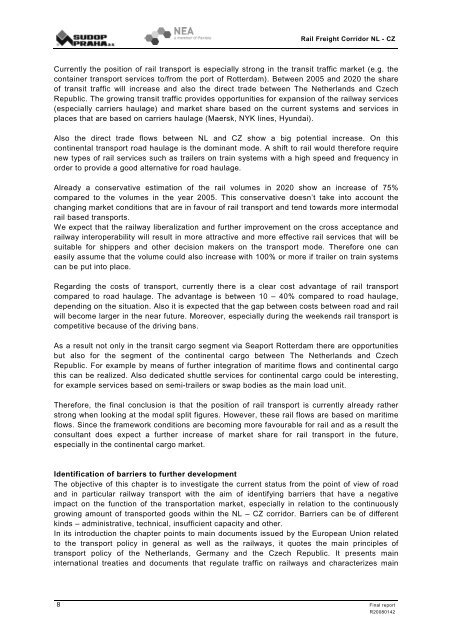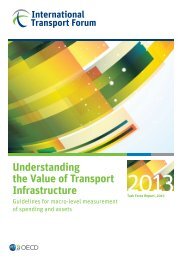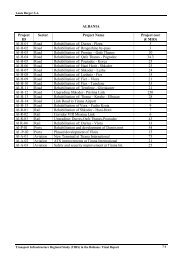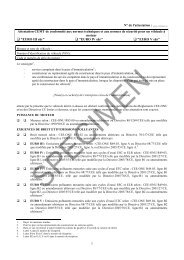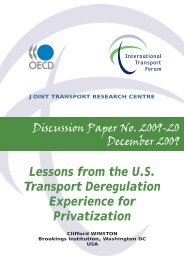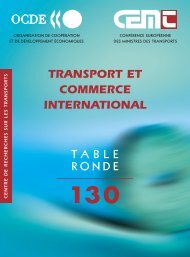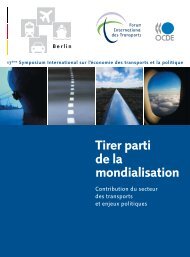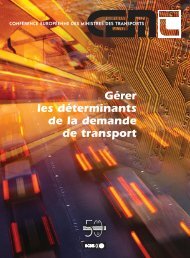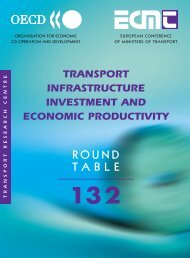Rail Freight Corridor NL - CZ final version - International ...
Rail Freight Corridor NL - CZ final version - International ...
Rail Freight Corridor NL - CZ final version - International ...
You also want an ePaper? Increase the reach of your titles
YUMPU automatically turns print PDFs into web optimized ePapers that Google loves.
<strong>Rail</strong> <strong>Freight</strong> <strong>Corridor</strong> <strong>NL</strong> - <strong>CZ</strong><br />
Currently the position of rail transport is especially strong in the transit traffic market (e.g. the<br />
container transport services to/from the port of Rotterdam). Between 2005 and 2020 the share<br />
of transit traffic will increase and also the direct trade between The Netherlands and Czech<br />
Republic. The growing transit traffic provides opportunities for expansion of the railway services<br />
(especially carriers haulage) and market share based on the current systems and services in<br />
places that are based on carriers haulage (Maersk, NYK lines, Hyundai).<br />
Also the direct trade flows between <strong>NL</strong> and <strong>CZ</strong> show a big potential increase. On this<br />
continental transport road haulage is the dominant mode. A shift to rail would therefore require<br />
new types of rail services such as trailers on train systems with a high speed and frequency in<br />
order to provide a good alternative for road haulage.<br />
Already a conservative estimation of the rail volumes in 2020 show an increase of 75%<br />
compared to the volumes in the year 2005. This conservative doesn’t take into account the<br />
changing market conditions that are in favour of rail transport and tend towards more intermodal<br />
rail based transports.<br />
We expect that the railway liberalization and further improvement on the cross acceptance and<br />
railway interoperability will result in more attractive and more effective rail services that will be<br />
suitable for shippers and other decision makers on the transport mode. Therefore one can<br />
easily assume that the volume could also increase with 100% or more if trailer on train systems<br />
can be put into place.<br />
Regarding the costs of transport, currently there is a clear cost advantage of rail transport<br />
compared to road haulage. The advantage is between 10 – 40% compared to road haulage,<br />
depending on the situation. Also it is expected that the gap between costs between road and rail<br />
will become larger in the near future. Moreover, especially during the weekends rail transport is<br />
competitive because of the driving bans.<br />
As a result not only in the transit cargo segment via Seaport Rotterdam there are opportunities<br />
but also for the segment of the continental cargo between The Netherlands and Czech<br />
Republic. For example by means of further integration of maritime flows and continental cargo<br />
this can be realized. Also dedicated shuttle services for continental cargo could be interesting,<br />
for example services based on semi-trailers or swap bodies as the main load unit.<br />
Therefore, the <strong>final</strong> conclusion is that the position of rail transport is currently already rather<br />
strong when looking at the modal split figures. However, these rail flows are based on maritime<br />
flows. Since the framework conditions are becoming more favourable for rail and as a result the<br />
consultant does expect a further increase of market share for rail transport in the future,<br />
especially in the continental cargo market.<br />
Identification of barriers to further development<br />
The objective of this chapter is to investigate the current status from the point of view of road<br />
and in particular railway transport with the aim of identifying barriers that have a negative<br />
impact on the function of the transportation market, especially in relation to the continuously<br />
growing amount of transported goods within the <strong>NL</strong> – <strong>CZ</strong> corridor. Barriers can be of different<br />
kinds – administrative, technical, insufficient capacity and other.<br />
In its introduction the chapter points to main documents issued by the European Union related<br />
to the transport policy in general as well as the railways, it quotes the main principles of<br />
transport policy of the Netherlands, Germany and the Czech Republic. It presents main<br />
international treaties and documents that regulate traffic on railways and characterizes main<br />
8 Final report<br />
R20080142


